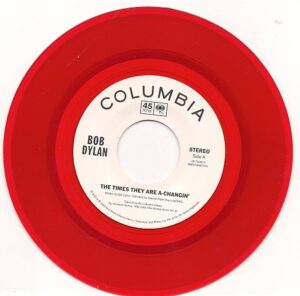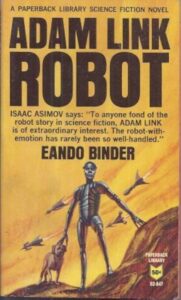Customer Avoidance has replaced Customer Service
Most of the time, when new technology comes into play, and the old ways of doing things vanish into the past, we miss them – and then we adjust. The advent of the motorcar destroyed the horse-and-buggy industry, but nobody wants to go back.
But there is something I’m missing as human beings are being diminished and robots and automation take over. And that’s customer service.
When listing our Big Lies, add this one:
“Please hold. Your call is very important to us.”
I don’t think so. I think our phone calls to big companies are intentionally avoided. Actually serving a customer is anathema to them, and they don’t wish to deal with it.
It’s just one aspect of the rapid advance of automation and robotics. Customer service was great while it lasted. But high tech has overcome high touch. Get used to it.
AUDIO: Random Samplings of a Logical Mind

Here’s a pressing of Dylan’s “The Times They Are A-changin'” that appears to be on red vinyl (Columbia Records)
What is disruptive technology?
This term refers to technology that comes along and destroys what came before. The best example is recorded music. If you were born in the forties or early fifties, you probably remember old 78 R.P.M. records. They were made of shellac resin and if you dropped them, they would shatter. Record albums were assembled by selling a box set of 78s in booklet form. But 78s were not the first records. They replaced the old cylinder recordings.
The 78 singles were replaced by 45 R.P.M. vinyl discs with large holes in the center. They were smaller – just 7 inches in diameter, and if you dropped them, they were sturdy enough not to break. Capitol Records and RCA Victor Records were almost always vinyl, but Columbia often used pressing plants that made 45s out of polystyrene. They were breakable and didn’t last as long, but most people never noticed the difference.
Vinyl long-playing albums replaced the 78 box sets. They ran slower at 33 1/3 R.P.M. and were 12 inches across. RCA even promoted “Dynaflex,” that they claimed was a new development in record manufacturing. At one point, some albums carried a promise about the longevity of the record:
“It cannot become obsolete.”
But it did.
The four-track tape, followed by the eight-track tape, followed by the cassette tape all disrupted records. But it was the CD that killed them. First known as C-DADs (compact digital audio discs), they were smaller, digital, and easier to store. They were virtually indestructible and never wore out. The perfect format.
But streaming, digital downloads, and even You Tube did them in. Lots of people still have them, including me, but the technology advances, and will advance again.
And some people (like me) kept their 45s and 33s and we’ve seen a resurgence in popularity with people who think they’re “warmer” sounding than digital audio. Score one for analog sound!
All this to say that the times, they are a ‘changing.
Bob Dylan had no idea about changes in technology when he wrote the song. It was about parents losing control of their sons and daughters to the new generation and how they would change the world by protesting wars and poverty and such. But we still have those things. What we don’t have much of is customer service.
Taco Bell and McDonald’s are now almost totally committed to kiosks or ordering screens. You can learn to use them fairly easily, but they mean fewer humans and fewer jobs. The more the Left tries to raise wages for fast food workers, the more automation we will see.
Elon Musk is reportedly going to test driverless taxis in Austin. These taxis will not even have steering wheels. There may be accidents involving them, but driverless cars are here and they are not going away. (Note the driverless solar buses in my 1978 story, “A Stitch in Time”.) What’s next? Driverless trucks? Pilotless airplanes? It’s all inevitable as what we used to think of as science fiction is rapidly coming true. Who knows what the AI age will bring?
RELATED: Stitches in Time: A Trilogy – Now Available from Planet Logic Press
Does customer service need humans?
My answer would be yes. Big Corporations’ answer is increasingly no. Case in point: last week, I wanted to ask if I could change my prescription insurance. It’s an Aetna plan, and I was past the deadline to switch because I failed to heed Joe Namath’s warnings. I thought I’d call and ask someone at Aetna about my options. After suffering through the usual recordings, and choosing English, and so on, I finally got a human operator. She was a very sweet young-sounding girl in the Philippines. My call was important to her. But she couldn’t answer my questions. I found out on my own that I was stuck with the plan I have until next year.
Here’s another situation I ran into, trying to advertise my new book (which EVERYBODY ought to read!) on Amazon. It’s all automated. It took several tries, but I got through the steps and hit the button. Maybe it worked; maybe it didn’t. I’m still not sure. I tried to find a phone number to ask an Amazon specialist if I did it right, and how I could do it better. I never was able to connect with anyone. Instead, Amazon provided me with links to articles and videos on how to do this. They helped some. I still wanted human guidance.
Is there customer service in our future?
I think there will be some, but it will not come from live human interacting with you in person or by phone. Even if you think it’s a human, it will be an AI. The days of going downtown and walking into the “gas company” or the “light company” as we used to call them, and sitting across from a human are over.
It was nice while it lasted, but companies were locally or regionally owned. They maintained local offices. That’s over.
Most people don’t even realize that convenience stores used to provide customer service.
That’s right. You’d pull into a 7-11 and roll your window down. A clerk would walk out to the car, take your order, and then fill it on the spot. You’d pay with cash and he’d bring your change. It’s interesting that COVID brought this back in a new form. Now you can order groceries online (no human involvement) and someone will bring it to your car. You have to wonder how long this service will last – or is it a permanent thing? Here’s the problem with this: it takes human beings to walk through the stores and fill the orders and take them out to a car. How will the stores get around this problem?
Remember, Amazon is experimenting with drones to deliver your package to your porch without humans being involved. There are ways. Sam’s Club already has an annoying robot that prowls the isles to check on inventory. It’s not in human form. Yet.
Is a robot just an automated arm or a program that does one task? Is it something with arms, legs, and a brain?
Who knows what a robot will be so long as people like Elon Musk, and Jeff Bezos are pushing the envelope. Science fiction gave us serious robots such as Eando Binder’s Adam Link, Gort from “The Day the Earth Stood Still,” and Star Trek’s Lieutenant Commander Data. It also gave us “Robbie” from the groundbreaking movie “Forbidden Planet.” Some of these robots had human-like qualities and, like Data, could learn to become more and more human.
We will get humaniform robots in time. They may become indistinguishable from actual humans. Like Data, some may be “fully functional.” My guess is they will become ubiquitous. A robot already can anchor the news on TV.
They might be built strong enough to do construction work, pick fruit, make beds, and work 24 hours a day without salary, sick days, or benefits.
They can also fill those online orders at your local grocery store – without human involvement. And that’s what might complete the circle. If customer service ever returns to the personal level it used to have, it will be robots with artificial intelligence that make it happen. It will be a brave, new world unless AI, like Hal in “2001: A Space Odyssey” decides to take over from humans. But that could never happen. Could it?
 Lynn Woolley is a Texas-based author, broadcaster, and songwriter. Follow his podcast at https://www.PlanetLogic.us. Check out his author’s page at https://www.Amazon.com/author/lynnwoolley.
Lynn Woolley is a Texas-based author, broadcaster, and songwriter. Follow his podcast at https://www.PlanetLogic.us. Check out his author’s page at https://www.Amazon.com/author/lynnwoolley.
Order books direct from Lynn at https://PlanetLogicPress.Square.Site. Email Lynn at lwoolley9189@gmail.com.
There are no robots in this book, but there are driverless buses! And they play a HUGE role in the first story.


